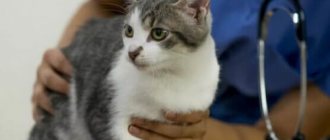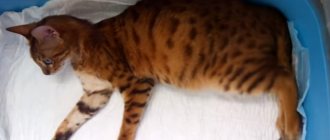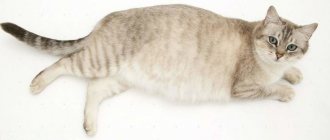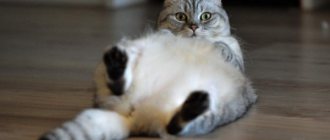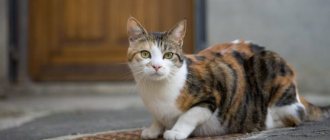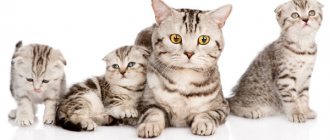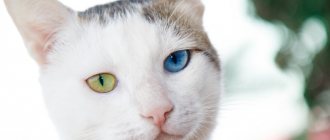The domestic cat is a placental mammal, like humans, so the principle of conception and pregnancy is similar. Cats are characterized by multiple births; one litter brings up to five to seven kittens. A healthy young cat can become pregnant and give birth up to three times a year, although this regimen is not recommended for many reasons. Finding out details about cat pregnancy is useful not only for professional and novice breeders, but also for simply pet owners.
Signs of pregnancy
It is currently not possible to determine whether a cat is pregnant with any tests. The presence of pregnancy in special cases can be determined using ultrasound, starting approximately on the 15th day after coverage. An experienced doctor will also be able to determine pregnancy approximately on the 20th day after plating by palpation, but not later, since the uterus will be filled with fluid and it will be possible to feel the fruits only at 49-55 days. Palpation of the abdomen requires great care and experience; to avoid damage to the fetus, do not do it yourself!
In the first three weeks of pregnancy, the cat becomes less active, eats less, and may even start vomiting. Baksin-vet is very good for nausea. Typically, the first sign of pregnancy is that three weeks after successful mating, the nipples become a distinct pink color, which is especially noticeable when the cat is pregnant for the first time.
Around the sixth week of pregnancy, if more than one or two kittens are formed, the cat's belly suddenly becomes very large, clearly larger than before: at this stage, the embryos grow rapidly and they cannot be felt individually. After the seventh week, you can already feel the kittens moving and feel their heads. By this time, the cat becomes restless, looking for a place in which to build a nest.
During the last week, the mammary glands enlarge and nipples protrude. The cat becomes somewhat aloof and inactive, sometimes a slight white discharge appears at the exit of the vulva.
Some pregnant cats show signs of heat during the third and sixth weeks of pregnancy, meaning they come into heat every three weeks. This is due to the fact that not enough progesterone is produced (this hormone is produced by the ovary during pregnancy, stopping the development of other follicles from which eggs emerge). If the cat is allowed, it will again have sexual intercourse and become fertilized, and these new eggs may also be fertilized. The result will be that at the same time there will be embryos of different ages in the cat’s uterus (the phenomenon of superfetation). If this happens, all kittens may be born at the same time, with the second litter being premature (usually rarely surviving), but in rare cases they are born separately, with the second litter being born later.
How to determine if a cat is pregnant
Every owner wants their cat to produce healthy and beautiful offspring. To do this, you need to take into account that childbirth is a very complex physiological process that requires a certain age and frequency:
- It is absolutely not worth breeding females under one year old. The age at which it is recommended to start mating is 18 months.
- The optimal maximum number of births per year is 2 times.
- The maximum age for breeding is 5 years.
Most individuals are already ready to conceive, starting at 6 months. But early childbirth is very harmful for a young body. It continues to develop until the age of two. However, some breeds are fully formed by the age of three, but can become pregnant earlier.
You should knit no earlier than a year
Now we will talk about uncontrolled reproduction , when the female walks wherever she wants . At the same time, her owner really does NOT want additional furry tenants to appear in the house.
It is very important to track the cat's first heat (this is a signal that she is ready to breed). There are no obvious signs of estrus. Therefore, you need to think about an unplanned pregnancy of a cat, even if she is still small. It is difficult to calculate the exact age of conception.
If you do not want your pet to give birth prematurely, then starting from five months, limit access to the street and cats to at least 8 months.
If you are not at all interested in procreation, then it is best to sterilize your pet. The recommended age for the procedure is eight months. The operation prevents not only unwanted pregnancy. Sterilized animals live longer because the body does not wear out as much and gets rid of gynecological diseases. In addition, the animal will not suffer due to unmet needs.
It's better to sterilize your cat if you don't want to breed kittens.
But in any case, you need to know and see the first signs of pregnancy. They appear in the second or third week after sexual intercourse. The first symptoms are the absence of estrus and morning sickness. Also, the expectant mother's nipples turn pink and swell, and the hair around them falls out. These signs do not always appear, so an ultrasound examination will help to more accurately confirm the position. The procedure is carried out in the third week after mating.
A few more characteristic signs:
- Lethargy.
- Change in appetite.
- Changing tastes.
- Affection is shown.
- Gaining weight.
- A pregnant cat's belly appears at 5–6 weeks.
Cat in a conspicuous position
- In later stages, breathing becomes heavier.
Feeding a pregnant cat
During the first four weeks of pregnancy, feed your cat kitten food or high-quality all-purpose food such as Orijen, Acana and Go! They contain everything necessary for the normal development of the fetus. Many cats during pregnancy and feeding kittens have a very uneven appetite for meat, try to encourage this by giving raw frozen beef or veal every day. But it is better to avoid treats and “pieces from the table”, as this can reduce the cat’s appetite, and, therefore, she will not receive the calcium, vitamins, proteins and other useful components of dry food she needs. Also, do not give your cat vitamin supplements - dry food contains everything it needs, and an excess of vitamins can negatively affect kittens. The exception is when the pregnant cat is weakened. Only a doctor can determine these exceptions! From the second half of pregnancy, the cat's need for nutrients increases, so it is worth increasing its diet by 50%. Offer your cat 2-3 times a week baby cottage cheese (and possibly more often), cheese or fermented baked milk. If desired, fermented milk can be given every day, but separated by feeding time with meat. For example, cottage cheese in the morning and meat in the evening, then calcium and iron will be absorbed. Keep an eye on your cat and avoid obesity. An obese cat can carry very large kittens, which in turn can lead to a difficult birth. But you shouldn’t underfeed either.
How long does a cat's pregnancy last?
Pregnancy in these animals lasts approximately 9 weeks. Varies from 55 to 63 days. Labor may begin a week earlier or later. It often happens that offspring are born earlier and still grow up healthy.
Pregnancy lasts different amounts of time for different breeds and types. Short-haired individuals bear offspring for 58–68 days, and long-haired individuals bear offspring for 62–72 days.
Labor begins earlier in the following cases:
- A large number of kittens in the litter (up to 57 days).
- Illness during position.
- Young individuals can give birth even on the fiftieth day (but in this case the offspring may be unhealthy).
- Small cats walk with a belly for no more than 65 days.
- Premature labor can begin when there is a sharp change in temperature.
- Weakly developed embryos die inside the animal, causing birth to occur earlier.
- Due to severe fright.
Childbirth will begin earlier if there are a large number of kittens in the litter.
Causes of delayed birth:
- Small offspring.
- Stressful state before childbirth.
- Large and adult cats stay pregnant longer.
- Frozen pregnancy.
- Hypoxia of kittens.
Larger individuals bear offspring longer
An ultrasound can find out the exact cause of the delay.
Preparing for childbirth
As a rule, the cat copes with childbirth on its own, but you need to be prepared for any turn of events, so a complete birth kit includes:
necessary
- Childbirth box (this can be either a cardboard box or a reusable box with a removable lid and an opening at the level of the cat’s chest.)
- Absorbent diapers (diapers can be replaced with a regular pillowcase in which paper towels are laid in several layers to absorb moisture and odors, while the edges of the pillowcase should be hidden so that the kittens cannot get inside.) After giving birth, the diaper will need to be updated.
- Scissors (disinfected with alcohol or an alcohol-containing solution)
- Lots of clean towels
- Gamavit
additional
- Vaseline oil
- Soap solution
- Electric heating pad (to maintain nest temperature)
Place for birth
The cat should give birth at home, where everything is familiar to her and where she feels safe, since if the cat is nervous, she can artificially delay labor. Therefore, the birthing house should be located in a quiet, shaded, dry place where the cat will not be disturbed. The room must be clean, dry, well ventilated and warm. Small kittens are very sensitive to humidity and temperature; they die from dampness and cold. For the first week of life, the temperature in the nest should be approximately 29 degrees, then drops by 3 degrees weekly to 21. To maintain this temperature, a heating pad is placed at the bottom of the box, or infrared lamps are hung above the box. At the same time, there should always be an unheated place in the box so that if the cat gets hot, she can move there, otherwise the cat will often leave the kittens.
In addition, during the birth, it is worth stocking up on another small box with a heating pad or bottles of warm water in case the cat for some reason cannot take care of the kitten and needs to be warmed up.
For the “nest” itself, a box with disposable baby diapers (sold in a pharmacy) is suitable, on top of which it is better to put cotton or linen cloth. The edges must be tucked in so that the kitten cannot crawl under them and get entangled. Under no circumstances should you use soft napkins or torn paper, as they may stick to the kitten’s body and the mother will refuse to lick it. Such a kitten is in danger of choking in the amniotic sac. Place the box in a warm, protected location, preferably the location where the cat's pregnancy primarily occurs. Make sure everything is ready at least two weeks before the birth.
Diagnosis and false pregnancy
To find out for sure that pregnancy has occurred, you need to consult a specialist. The doctor will conduct an examination and, if necessary, prescribe additional examination methods:
- An examination by a veterinarian involves palpation to identify fetuses, as well as an external examination of the genital tract and the general condition of the cat.
- A positive result of a blood test for relaxin will indicate with high accuracy the onset of fertilization from the 25th day.
- Ultrasound allows you to accurately diagnose pregnancy from day 25.
- X-rays are performed after 50 days.
Cats are characterized by the phenomenon of false pregnancy. The etiology is not fully understood, but experts are inclined to believe that the cause of the condition is the effect of the hormone prolactin. Imaginary pregnancy in cats occurs after ovulation in the absence of fertilization of the egg. At the same time, the cat shows signs of conception - changes behavior, nests, and stops estrus.
False pregnancy can be diagnosed by a negative test result for relaxin, the absence of fetuses on palpation, according to ultrasound and radiography.
Signs of approaching labor
A week before giving birth, the cat begins to lick itself more often, especially the abdominal and genital area. She begins to climb through cabinets and look for a place for a nest. At this time, it is worth showing her the birth box. If she suddenly gives birth in another place, then immediately after giving birth, transfer her and the kittens to a box. From the 61st day of pregnancy, you can take your cat's temperature daily. 12-24 hours before birth, it drops from 38.6 to 37.5 or lower (but this moment can be skipped); normal temperature is not a sign that the cat will not begin to give birth in a few hours.
Caring for a young mother and kittens
In the first days, it is not advisable to get too close to the nest, much less pick up the babies. A mother will almost always act aggressively in an attempt to protect her children, even if she previously trusted the person. During this time, you need to provide food, water and a tray nearby, since cats do not go far from the nest.
A cat that has given birth constantly feeds its babies, so it still needs extra nutrition. In the first days, kittens are completely dependent on mother's milk, but after a month it is necessary to introduce complementary foods in the form of a special diet for babies. The need for breast milk decreases, almost disappearing by three months.
Childbirth
Labor begins with the breaking of gray-red water, dilation of the cervix and birth canal. During this period, the cat begins to struggle and breathing quickens. The cat strains and may meow pitifully. This period can be 12 hours or more, during which time the horns of the uterus contract alternately, pushing the fetuses into the uterus. When the uterus contracts, the fetus is pushed toward the cervix, which dilates, the abdominal muscles contract, and the fetus ends up in the vagina. If a cat gives birth for the first time, she may be very scared of this condition and seek help from her owner! Sit with her, pet her, talk - cats are very sensitive to the voice of the owner, and your words will calm her down. During the next period of labor, a water sac surrounding the fetus appears between the cat’s labia, and then it ruptures and a straw-colored liquid flows out of it, which lubricates the passage and facilitates the advancement of the fetus. A few minutes later the kitten is born. If the amniotic sac ruptures while still in the birth canal, the kitten should be born no later than 30 minutes.
Normal birth
Most kittens are born head first, and once the head is born, the rest of the body quickly slips out. The mother breaks the amniotic membranes, grinds the umbilical cord with her teeth and begins to intensively lick the kitten's face, freeing its airways from mucus. The kitten takes its first breath, its lungs expand and it begins to breathe. If the cat does everything correctly, you cannot interfere with this process, but if, while licking the first kitten, she forgets about the second or for some other reason does not take care of the newborn, just born, then you must remove the membranes for her, otherwise the kitten will suffocate . To do this, tear the membrane in the direction from the mouth to the tail, then use a pear or pipette (in case of emergency, use your mouth, just not too much) to suck out the mucus from the mouth and nose; as soon as the kitten squeaks, it means it is breathing. Then rub the kitten with a soft towel. Mucus from the mouth can be removed by fixing the head and sharply turning the kitten upside down. After this, return the baby to the cat so that she can sniff and lick him.
After the kitten is born, the placenta is delivered some time later. The mother usually eats the placenta, but this can sometimes cause diarrhea. Let your cat decide for herself; if she feels the need for nutrients, then let her eat. Often, after eating the placenta, the cat feels better and the shortness of breath decreases. Make sure that there are as many afterbirths as there are kittens. If the placenta remains inside, it will begin to decompose, which will lead to very serious consequences. To avoid this after birth, it is advisable to inject Gamavit subcutaneously (in the withers, for example); it also promotes the cat’s rapid recovery after childbirth.
The cat rubs the umbilical cord in such a way that the blood vessels are stretched and twisted, and as a result there is no bleeding. If bleeding does begin, you should apply a clamp or hold it with your fingers and tie the umbilical cord with thread. If the cat does not gnaw the umbilical cord itself, then you should do it yourself by rubbing the umbilical cord approximately 2 cm from the kitten’s abdomen with the edge of your nails, then there will be no bleeding.
When childbirth proceeds normally, it is better not to disturb the cat; she herself knows what to do. However, if the kitten is large, then it can get stuck in the vagina, and during contractions the head appears outward, and then disappears again when the cat relaxes. At this time, the cat needs your help! Lubricate the vaginal opening with Vaseline or a special gel. During the next contractions, when the head appears outward, you need to press the perineum under the anus down to prevent the kitten from going back. Then pull the kitten outward by the skin near the neck. Do not pull on the head or limbs under any circumstances, as this can lead to injury and death of the kitten. If the kitten comes out very tightly, then you can pull it with rocking (unscrew), first in one direction, then in the other.
Typically, kittens are born approximately every 20 minutes. However, this time is very approximate, and after the birth of several kittens, a cat may delay the birth of the rest by 12-24 hours.
Pathological birth
Pathological birth can occur as a result of mechanical blockade, i.e. when a kitten cannot be born due to the large size or incorrect position of the fetus, as well as as a result of weak labor (weak contractions of the uterus). Weak contractions are most often the result of strong stretching of the uterus, which reduces the force of its contraction, this can happen due to a very large kitten, due to too many kittens, or due to an excess of amniotic fluid.
If the cat is having strong contractions but cannot give birth within 1 hour, if the cat is bleeding (blood flows for more than 10 minutes after birth), if the temperature has risen to 40 degrees or dropped below 36, if the contractions have stopped and the cat is worried, rushes about, or if kittens are born more than 3 hours apart, then you should immediately call a veterinarian!
If the kitten has a ruptured amniotic sac (as evidenced by the cat's discharge of straw-colored fluid), then you must help the kitten yourself, without waiting for the doctor to arrive, otherwise he will suffocate. To help your cat, treat the vulva with soapy water, put on sterile gloves and lubricate them with Vaseline or gel.
If the kitten is in the birth canal, then you should put one hand under the belly, feel the kitten and turn it along the birth canal, then carefully insert your finger into the vagina along the body (be careful not to touch the anus to avoid contamination with feces) and feel the tail and limbs or head.
If the kitten is head first and cannot be born due to a bent head, then gently insert your finger into the kitten's mouth and gently turn the head into the correct position, then press on the cat's perineum under the anus, this will force the muscles to contract and hold the fetus in the correct position.
If the kitten walks with its buttocks forward, then grab it with your finger, first by one limb, then by the other, pointing them slightly downward.
If the cat cannot give birth to a large kitten walking head first, then you need to carefully insert your finger along the kitten’s body, then feel for the belt of the forelimbs and, hooking it by the elbow, stretch first one, then the other leg forward.
If after this, during contractions, the head first appears and then disappears, then you should grab the kitten by the skin in the neck area with a sterile napkin and pull it out.
If the placenta is not born after one of the kittens, it should be pulled out independently to avoid difficulties in the birth of subsequent fetuses.
In order to induce contractions, you need to stroke the cat's back and stomach with your hands.
In case of weak contractions of the uterus, the cat should be helped by a veterinarian!
Stimulation of breathing in newborn kittens
As a rule, the cat itself licks newborns, but if for some reason it does not do this, then you must help the baby yourself. To do this, tear the amniotic membranes in the direction from the mouth to the tail, then use a pear or pipette to suck out the mucus from the mouth and nose (in an emergency, use your mouth, just not too much), then rub the kitten with a soft towel. Mucus from the mouth can be removed by fixing the head and sharply turning the kitten upside down. And after that, return the baby to the cat so that she can sniff and lick him.
If the kitten was born weak and cannot take the first breath on its own, then gently squeeze the chest from the sides, then from front to back, as if spreading the lungs in different directions. If the baby is still not breathing, then artificial respiration should be performed mouth to mouth and nostrils. Inhale air until the chest expands, but do not inhale with great force, this can lead to rupture of the lungs. After this, let the baby breathe out. Artificial respiration is carried out until the first spontaneous breath.
In all other cases not described in this manual, you cannot do anything on your own and you should urgently call a doctor!
After childbirth
Finally, the birth is over! Make sure that all kittens are at their mother's nipples, because in the first hours of life they must suck the first mother's milk - colostrum, with which immunity is transmitted to them from the cat. Kids, grow up strong and healthy!!!
After giving birth, the cat should be injected with Gamavit, it stimulates uterine contractions and promotes faster recovery of the cat, if she is still bleeding the next day, then Gamavit can be injected a couple more times. Also, immediately after giving birth, cats are stressed, they can fuss, behave restlessly and run to the kittens, then to the owner, and squeak. Therefore, we advise you to drink 3 capsules of Baksin-vet with a small amount of water (you can use a syringe without a needle), this puts the psyche in order =))) In the future, a nursing cat can be given Canina Cat-Mineral Tabs vitamins to avoid the risk of eclampsia or postpartum psychosis.
Pregnancy calendar - to help a beginner
For beginners, a special table will help you calculate how much to plan your birth on which day. The first day is considered to be the time 24-50 hours after mating - this is where the calculation is based. The cat's pregnancy calendar can be seen below. The gray column marks the first day of mating, and the next line marks the day of birth.
It is worth knowing that the cat pregnancy calendar shows the approximate day of birth. The value can change either down or up. Only a veterinarian can indicate the most accurate period.
What happens to a cat after giving birth?
The mother needs time to recuperate after lambing. It is necessary to monitor her condition so as not to miss alarming symptoms.
Normal state
For the first 5-7 hours (sometimes 24 hours), the mother may refuse to eat, which is considered normal if she actively laps up water. Trips to the litter tray may be suspended temporarily (up to 4 days). It is also possible for pink discharge to appear in the first 7 days after birth.
As for when a cat begins to produce milk, the norm is immediately after birth, when the first-born kitten begins to suckle. Minor delays due to stress are acceptable. After a short time, the cat will calm down and lactation will improve. Next, it is necessary to provide the woman in labor with peace, fresh food, and drink so that the milk does not disappear.
Signs of complications
Deterioration of condition after lambing is more often observed in very young, injured and purebred individuals. Domestic cats that are constantly in the fresh air and actively moving have stronger bodies, so difficult childbirth is practically excluded.
Pet owners need to monitor behavior to spot adverse symptoms early.
You should consult a doctor if you experience any of the following symptoms:
- the cat is anxious, restless or apathetic;
- no appetite for more than 24 hours;
- body temperature changed sharply: increased to 39.4 °C or fell below 36.1 °C;
- bleeding continues for more than 10 minutes;
- milk of abnormal color and/or consistency (yellowish, transparent, curdled);
- persistent vomiting and/or diarrhea;
- paws and/or head trembling;
- purulent or foul-smelling discharge within 3 weeks after birth;
- nipples are very hot and swollen;
- The cat doesn't care about kittens.
In females with very large offspring, milk fever (eclampsia) may develop due to a sharp decrease in calcium concentration in the body.
Signs of pathology in a cat:
- anxiety;
- rapid breathing;
- pallor of the mucous membranes;
- lack of coordination of movements;
- pointed muzzle with exposed fangs;
- temperature jump to 41.1 °C;
- convulsions, loss of consciousness.
Routine ultrasound during pregnancy
A specialist can prescribe an ultrasound scan at almost any time during pregnancy if the animal’s condition is in doubt. In the early stages, the owner can contact the veterinarian to confirm or deny the presence of pregnancy.
Next, the development of the fetus is monitored and the number of future kittens is determined. In any case, a visit to the veterinary clinic is recommended both for preventive purposes and if you experience feelings of anxiety about the condition of your pet.
Scheduled ultrasound
